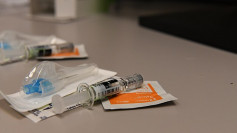The Biden administration has introduced a landmark new regulation targeting lead-based paint, aiming to protect children from the harmful effects of lead exposure. The Environmental Protection Agency (EPA) on Thursday announced strict limits on lead dust levels in older homes and childcare facilities built before 1978, the year lead-based paint was banned in the United States. This follows the administration's recent decision to replace lead pipes in drinking water systems nationwide, underscoring a broader effort to combat lead-related health hazards.
The EPA's new rule sets stricter standards for lead dust, lowering acceptable levels on floors and window sills to virtually undetectable amounts. This measure is intended to address lead contamination, which occurs when old paint deteriorates or is disturbed during renovations. "There is no safe level of lead," said Michal Freedhoff, the EPA's assistant administrator for chemical safety and pollution prevention, emphasizing the urgency of the new standards. She added that the rule brings the U.S. closer to eradicating lead-based paint hazards from homes and childcare facilities "once and for all."
The agency estimates that this rule will significantly reduce lead exposure for up to 1.2 million people annually, including between 178,000 to 326,000 children under six. Lead, a neurotoxin, can irreversibly damage brain development in children, leading to lower IQs, behavioral problems, and long-term health complications affecting organs such as the liver and kidneys. Even minimal exposure can cause severe developmental delays in young children, making this issue a priority for public health officials.
Environmental justice advocates have welcomed the EPA's new rule, noting that lead poisoning disproportionately affects low-income communities and communities of color. Peggy Shepard, co-founder and executive director of We Act for Environmental Justice, praised the new regulations. "We can all breathe a little easier now that the EPA has significantly lowered its dust lead standard to protect children," Shepard said. She highlighted the particular vulnerability of Black children in Harlem, where studies show they are twice as likely to suffer from lead poisoning as their white counterparts living in similar conditions.
Despite its positive reception, the rule has raised concerns about the potential financial burden it may place on property owners and childcare providers. The new regulations require property owners to clean lead-contaminated dust to levels that are essentially undetectable. This has drawn criticism from groups like the National Apartment Association, which represents landlords. Nicole Upano, assistant vice president of housing policy for the association, described the rule as imposing "an impossible task" on housing providers, who will now bear the sole responsibility for ensuring that lead levels reach zero.
Childcare centers, particularly those in low-income neighborhoods, also face significant challenges in complying with the stricter standards. Cindy Lehnhoff, director of the National Child Care Association, noted that while the rule is crucial for protecting children, it could exacerbate financial difficulties for many centers already struggling to stay afloat. "This will protect some young children in child care," Lehnhoff said, "but it will also create an unaffordable expense that will require government funding to implement."
In response to these concerns, the Biden administration has pledged additional funding to support lead abatement efforts. Earlier this month, the Department of Housing and Urban Development (HUD) announced $420 million in grants aimed at removing lead hazards from homes, including HUD-assisted housing. The White House has indicated that further grants will be available to help homeowners and childcare providers comply with the new regulations.
The new EPA rule represents a proactive approach to preventing lead exposure rather than simply responding to it. Dr. Philip Landrigan, a Boston College professor and public health expert, has long advocated for such measures, noting that previous efforts often relied on identifying elevated blood lead levels in children before taking action. "When you are relying on the blood lead level in children to indicate whether there is lead in the environment, we are basically using the children as canaries in the mine," Landrigan said. He praised the new rule as a more effective method of preventing lead exposure.
Lead-based paint remains a significant health hazard in the U.S. The EPA estimates that more than 30 million homes still contain lead paint, including nearly 4 million homes with young children. Although efforts have been made to reduce exposure, such as the removal of lead from gasoline and water pipes, lead dust from deteriorating paint continues to pose a serious risk, especially in older homes and childcare facilities.
Lead is a potent toxin that can cause a wide range of health problems. Exposure is most dangerous for young children, whose developing brains and bodies are particularly vulnerable. According to the Centers for Disease Control and Prevention (CDC), lead exposure can cause learning difficulties, slowed growth, hearing loss, and other developmental delays. It is also associated with behavioral issues such as attention deficit hyperactivity disorder (ADHD). In severe cases, high levels of lead exposure can lead to seizures, coma, or even death.






